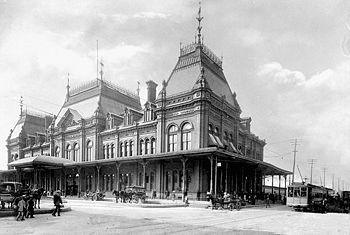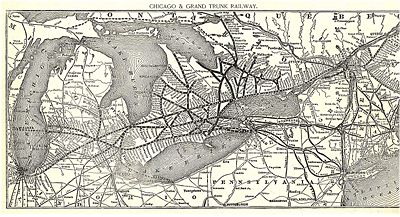Grand Trunk Railway/Citable Version
The Grand Trunk Railway (GT or GTR) was a 19th-century Canadian railway system based primarily in Ontario and Quebec with operations over much of Canada and neighboring parts of the United States. It grew rapidly, becoming at one time the railway with the greatest number of track miles in the world. Troubled financially by extending its route to the Pacific Ocean, the railway was nationalized by the Canadian government in 1921 and merged into Canadian National Railways in 1923. Portions of the Grand Trunk continued to operate under this name in the United States for a number of years.
Background
The impetus for constructing the Grand Trunk Railway grew out of mounting concerns during the late 1840s that Canada would languish economically if major steps weren't taken to improve its transportation infrastructure. Though a canal system was in place, it was becoming increasingly obsolete and losing trade traffic due to the development of the United States' railways.
Several laws passed between 1849 and 1852 paved the way for the emergence of a comprehensive Canadian railway policy, of which the Grand Trunk Railway project was a part. In particular, the Guarantee Act of 1849, which was crafted and introduced by Sir Francis Hincks, provided Canadian government subsidies for all railways longer than 75 miles. Three years later, Hincks secured passage of the Municipal Loan Fund Act of 1852, which created a Canadian government fund to support local infrastructural expenditures.
Construction
The Grand Trunk Railway was chartered in 1852 to build a railway between Toronto, Ontario and Montreal, Quebec. Construction started in 1853. By 1855, the section from Montreal to Brockville was complete. The following year, the section between Brockville and Toronto and another continuing from Toronto on to Stratford were also finished. By 1859 the line had been extended to Sarnia. The GT supplemented its construction efforts by buying five local railways between Sarnia and Montreal. It also acquired a 999-year lease on the Atlantic & St. Lawrence Railroad that provided access to the ice-free port at Portland, Maine.
Across lower Ontario, traffic grew quickly as the Grand Trunk made connections between Michigan (with access to Chicago, Illinois and the Western U.S.) and Buffalo, which served as a gateway to eastern markets. The Grand Trunk's early growth was stimulated by the enormous growth of U.S. trade after 1854 caused by Canadian-American reciprocity, which meant free trade between Canada and the U.S.
The London & Ottawa Connections
The Grand Trunk was backed by financiers based in London, where the railway's headquarters were established. To encourage investment, the railway published a prospectus, predicting that the amalgamated railway would be the most comprehensive system of railway in the world, comprising 1,112 miles from Portland to Lake Huron, and would be built to as high a standard as any in England.[1]
Throughout its life, London financiers funded the Grand Trunk's purchase or lease of 50 other railways, making it by 1869 the world's longest railway. Despite these bankers and its private ownership, the Grand Trunk quickly became vital to Canada, which became a unified dominion in 1869. The new Canadian government (located in Ottawa) also facilitated the GT's growth with subsidies and loan guarantees.
Late 19th Century Growth & Troubles
By the 1880s, the Grand Trunk had reached most major cities in Quebec, crossed into Maine and Vermont, and stretched into the fast-growing Detroit-Chicago corridor inside the U.S. It bought railways in Michigan, Indiana, and Illinois (U.S. state) to secure a route to Chicago. Apart from a 5-day strike in 1876, the GT avoided the labor violence that characterized most railways in the late 19th century.
In spite of its backers and the Canadian government, the GT was never profitable because of competition from Great Lakes shipping and American railways. In 1880, for instance, 40% of the Grand Trunk traffic was bridge traffic across the southern tier of Ontario between Port Huron and Buffalo and not bound for any Canadian destination. Inflated construction costs, overestimated revenues, and an inadequate initial capitalization threatened bankruptcy for the Grand Trunk.
Sir Joseph Hickson was a key executive from 1874 to 1890 based in Montreal who kept it afloat financially by allying it with the Conservative Party. Carlos and Lewis (1995) showed that the Grand Trunk managed to survive because its British investors accurately assessed the corporation's value and prospects, which included the likelihood that the Canadian government would bail out the railway should it ever default on its bonds. The government had guaranteed a very large loan and had enacted legislation authorizing debt restructuring. Such arrangements allowed the company to float new bond issues to replace existing debt and to issue securities in lieu of interest.
The Pacific Extension
American executive Charles Melville Hays (1856–1912) joined the Grand Trunk in 1895 as general manager (and in 1909, as president, based in Montreal). Hays was the architect of the great expansion during a colorful and free-spending era. He upgraded the tracks, bridges, shops, and rolling stock, but was best known for building huge grain elevators and elaborate tourist hotels such as the Chateau Laurier in Ottawa.
Hays's most controversial decision was to build an extension to the Pacific Ocean in 1903. The GT established a subsidiary, the Grand Trunk Pacific Railway, for this purpose. This extension was some 4800 km long and built between Winnipeg, Manitoba, and Prince Rupert, British Columbia. The extension was completed in 1914 (two years after Hays's death). To connect this extension with the rest of the GT system, the Canadian government built the National Transcontinental Railway (NTR) which the Grand Trunk Pacific was to operate, though the company backed out of the agreement to operate the NTR before the NTR's completion. The Pacific extension, however, had problems. The very expensive subsidiary was too far north of major population centers and had far too little traffic. The cost of constructing the Pacific extension and the meager returns in operating it led the GT towards bankruptcy after World War I. In order to avoid the break-up of this transcontinental railway network threatened by bankruptcy, the Canadian government nationalized the entire system. The Grand Trunk Pacific was acquired in 1919 after the Grand Trunk announced it could no longer operate it, and then merged into the new Canadian National Railways. The Grand Trunk was nationalized in 1921 and merged into Canadian National Railways in 1923.
The Remnants of the Grand Trunk
The Grand Trunk name survived on Grand Trunk's former United States lines. In 1928, Canadian National Railways consolidated its lines in Michigan, Indiana, and Illinois into the Grand Trunk Western Railroad, a separate company owned by the CNR. The Portland line also kept the Grand Trunk name until it was acquired by a shortline operator in 1989.
Notes
- Subpages
- Engineering Extra Subpages
- History Extra Subpages
- Business Extra Subpages
- Railroad History Subgroup Citable Versions
- Business History Subgroup Citable Versions
- Engineering Approved Extra Subpages
- History Approved Extra Subpages
- Business Approved Extra Subpages
- Citable versions of articles
- Engineering Citable Version Subpages
- History Citable Version Subpages
- Business Citable Version Subpages
- All Content
- Engineering Content
- History Content
- Business Content
- History tag
- Railroad History tag
- Business History tag

